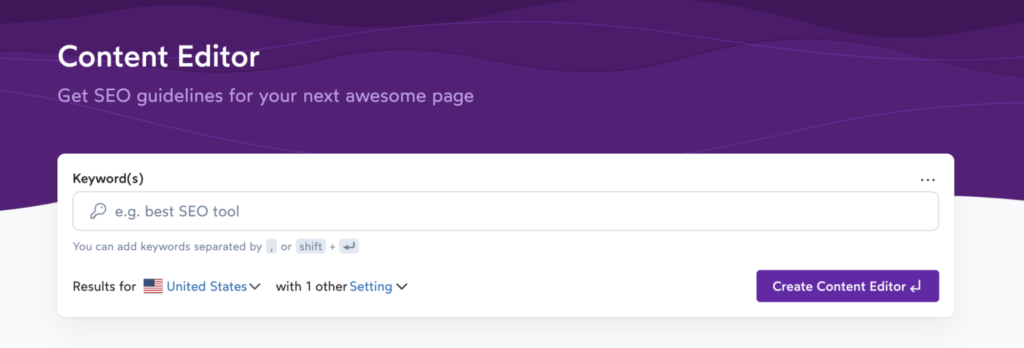Business owners in the ecommerce industry recognize the importance of ranking high in search engine results pages (SERPs). Succeeding in business is dependent on consumers being able to find your online store, which means successful ecommerce SEO is vital to your bottom line.
If you’re wondering, “How do I get more traffic to my website?” This post is for you. Learn all about ecommerce SEO best practices and tips so that you can develop a comprehensive SEO plan for your ecommerce website.
Key takeaways
- Ranking high in the SERP is crucial for ecommerce sites.
- Keyword research, technical SEO, and SEO tools can help you boost rankings.
- Pay attention to site structure and user experience when developing SEO strategies.
What is ecommerce SEO?
Ecommerce SEO refers to the search engine optimization surrounding ecommerce websites. It is the process of generating organic traffic—via technical SEO or keyword research—from search engine sites like Google, Yahoo, and Bing. Ecommerce SEO is crucial for online businesses who want to successfully market their products or services, making it easy for customers to find them and learn about them online.
The importance of ecommerce SEO
Do you own or manage an online business? Then you should know that it’s crucial to rank high in the SERP. Whether your shoppers use Google or Bing, they need to be able to easily find your store when searching online. 59% of shoppers have confirmed that they research products online before they buy, to ensure they make the best choice. In fact, ecommerce sites are the front doors to any online store.
For this reason, it’s crucial to invest in SEO for ecommerce sites. Online stores are only as strong as their search results. If consumers can’t find your services or products, how will you make any sales? This post will explore the different strategies to obtain a high ranking on Google, general SEO strategies for ecommerce, tools that can be used, and other pieces of key SEO knowledge that will help inform your strategy.
How to rank first on Google
The goal of your ecommerce SEO campaign might be to rank first on Google, or at least show up on the first page of results. 75% of shoppers utilize Google products to do their shopping—hence making Google ranking a critical component of your ecommerce SEO strategy.
Understanding the different areas of Google
There are six different ways your ecommerce store can appear on Google:
- Google Search
- Google Images
- Google Lens
- Google Shopping
- Google Business Profile
- Google Maps
Each of these areas of Google is important for ensuring your ecommerce site rates high on Google. SEO efforts should consider each of these Google products if you want to increase visibility for your business.
Everyone is familiar with Google Search and Google Images, but what about the other areas of Google? Google Lens is a mobile device camera app that can be used to identify products, while Google Shopping gives customers the ability to view many similar products at once. If you add location inventory data, your products could appear on Google Maps. Finally, a Google Business Profile can act as a mini storefront for your products.
Best ecommerce SEO practices for Google
It may seem overwhelming to decide which area of Google to focus on as an ecommerce store. Thankfully, Google offers a Google Merchant Center account—for free—where store owners can submit their products into a data format that functions well with Google. If your ecommerce site provides ample information about each of your products, Google is more likely to pull up your page for specific searches.
Putting SEO focus into the Google Merchant Center will help your store achieve its goal of ranking first on Google. With specific product pages full of helpful information and keywords, you’ll make it easier for customers to discover your offerings.
Developing your ecommerce site SEO strategy
Just like customer retention, ecommerce SEO strategies aren’t a one size fits all solution. All ecommerce stores are different, which means business owners should try out different strategies to see what works best for them. In order to develop an ecommerce SEO strategy, you have to know the vital components of SEO.
Keyword research
Every piece of content for your ecommerce site starts with keyword research. There are many tools that can assist with ecommerce keyword research, along with your own keyword ideas. One way to identify keywords is to think about the Google search your customers will make, the questions they have, and what they might search when looking for your product or services online.
Product pages, blogs, and landing pages can all be optimized to include important keywords, making them more popular on Google. This type of on-page SEO for ecommerce is crucial for getting the search results you want. There are a few different types of keywords you should focus on when doing keyword research and creating content.
Primary keyword
For every piece of content—whether it’s a product page, blog post, or landing page—you should identify a primary or target keyword. The primary keyword should be used generously throughout the page, in order to increase optimization. It’s typically easy to identify what the target keyword should be because it almost always centers around the main topic of the content.
Informational keywords
Informational keywords are keywords that indicate the searcher is looking for information, as opposed to buying a product (commercial) or looking for a specific website or place (navigational). Within ecommerce SEO, informational keywords can be used to inform consumers about your product or service, or topics relevant to your business. Many ecommerce sites utilize a blog to share this information and increase organic traffic.

Long-tail keywords
Besides your average keywords, ecommerce sites should also pay attention to and utilize long-tail keywords. This type of keyword is longer and more specific than other keywords, which means it has a lower search volume but often a higher conversion value.
When considering advertising products and services, long-tail keywords are hugely important because they can help people searching for a specific item find exactly what they’re looking for. In the case of ecommerce sites, incorporating long-tail keywords can go a long way.
Borrowing from an example below, let’s say your website sells dresses. A great long-tail keyword you might use would be “long pink tulle bridesmaid dress.” Unlike primary keywords, these long-tail keywords include more detailed and specific information.
Keyword stuffing
Try to avoid keyword stuffing—that is, overly repeating phrases or words in posts and in the backend of the website. Though jamming in keywords can boost your on-page SEO, it isn’t appealing to readers. And search engines are routinely looking out for keyword stuffing and may flag your website as spam.
Meta descriptions
When you make a search on Google, you read a meta description—the short description included below the title of a webpage. If you want your ecommerce site to succeed in SEO, then you have to pay attention to meta descriptions. People have shorter and shorter attention spans, so writing catchy and informative meta descriptions is key.
Link building
No SEO strategy would be complete without considering linking. Links are a major component of SEO and one that Google and other search engines pay close attention to. When you consider ecommerce SEO strategies, there are several types of linking that need to be included, such as:
- Internal links
- Outbound links
- Backlinks
Many businesses pay for backlinks because they boost SEO scores. When your blog posts or landing pages are linked many times on other websites, it highly increases your ranking in Google searches.
The other types of links—both inbound and outbound—can be controlled by your writers or whoever is building the content on your site. Inbound or internal links direct readers back to other pages on your site, like blog posts and landing pages. Including a few internal links can provide more information and context, while increasing your SEO scores.
Outbound links, on the other hand, give your ecommerce site more credibility. Adding links from well-known sources, such as news sites or associations, show Google and other search engines that you’ve done your research. Outbound links can also act as a citation and are crucial for identifying your ecommerce site as credible and trustworthy.
Site structure
Your ecommerce site architecture is another important factor for SEO success. User experience is crucial for attracting and retaining customers, and it plays a role in how your site performs too. In other words, site structure cannot be ignored when setting up and managing your ecommerce store. Creating a user flow that makes sense will increase your SEO score.
“A good best practice is that ecommerce sites should focus on creating category or collection pages that represent a primary keyword,” says Tom Dehnel, an SEO consultant.
For example, if you sell dresses, you could create pages for homecoming dresses, spring dresses, and sweet 16 dresses. “By organizing an ecommerce website into categories that map to high-value keywords, you empower search engines to match up those pages to what customers are looking for in search engines.”
Once a customer clicks on a specific dress, they would then be taken to a product detail page. This page showcases information about a specific product, aimed to help prospective customers make a purchase. You should include details like dress color, images, sizing, shipping costs, and other relevant information.

Site speed
Some additional ways to ensure you have an optimal user experience include examining your site speed. Here are a few measures to take that will help with loading content:
- Utilize a “load more” button
- Limit products to a certain number per page, as identified by linked page numbers
- Continue to load products as the user scrolls, known as an “infinite scroll”
Examining user experience and site speeds will help you gain a bigger picture idea of how successful you will be at attracting organic traffic.
Technical SEO
To dive deeper into SEO, your ecommerce store can get into the more technical SEO side. This includes the following items, according to Big Commerce:
- Use Secure Sockets Layer (SSL)
- Make your site mobile friendly
- Increase site speed
- Create an XML site map
- Avoid duplicate content
- Add structured data markup to your website
- Register your site with Google Search Console and Bing Webmaster Tools
- Fix broken links
- Correct Product Schema
If you want to increase your organic search traffic, getting into the technical side of SEO can help. Though it might seem intimidating, many of these measures will help your ecommerce business grow and increase your search engine rankings. Hiring a professional to help with technical SEO is a great idea.
3 ecommerce SEO tools
Are you still wondering how to do SEO for an ecommerce website? These tools will help. Now that you understand more about how search engines work and what factors are essential to great ecommerce SEO, let’s dive into the tools that you can use to achieve successful search results.
Google Analytics
How do you know what you need to improve? You have to analyze your ecommerce website traffic. The best way to do that is by using Google Analytics, which records and analyzes site traffic, making it easy to see which ecommerce product pages are performing well and which could use some improvement.
Every ecommerce website should utilize Google Analytics as part of their SEO strategy.
Ahrefs
Ahrefs is a great resource for expanding your SEO game and achieving higher rankings. They boast themselves as an all-in-one SEO tool, with the following offerings:
- Site audits to optimize your ecommerce site
- Site explorer to analyze competitors
- Keyword explorer to find out what your customers are looking for
- Content explorer to view the top content on the web for your industry
- Rank tracker to see how you’re ranking
For those just getting started with search engines and ecommerce websites, Ahrefs can be the perfect tool to launch your SEO journey.
Surfer
Like Ahrefs, Surfer is another tool that offers a comprehensive look at SEO for ecommerce sites. From finding keyword ideas to planning your content strategy, Surfer can help you achieve the search results you want for your business. Plus, Surfer takes SEO a step further with their Content Editor, where writers can create content and optimize it in live time.

Key takeaways for ecommerce SEO best practices
Whether you’re looking for better ways to target keywords or want to boost your ecommerce site to the top of the search engine results pages, learning ecommerce SEO tips and best practices is the best place to start. There are a number of strategies that ecommerce sites can use to achieve optimal SEO results, including:
- Focusing on Google rankings
- Using analytics to determine areas of improvement
- Performing keyword research for every piece of content
- Using linking to boost on-page SEO
- Paying attention to technical SEO components
- Utilizing ecommerce SEO tools to get ahead of competitors
When you focus on these search engine optimization tactics, your ecommerce website will gain optimal organic traffic, meaning more revenue and visibility for your business.



